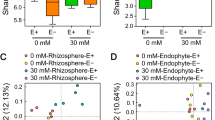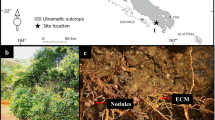Abstract
Our objective was simply to report a sedge species, Carex kobomugi Ohwi that has beneficial bacterial associations under low Fe and P conditions of the Hasaki coast, Japan. C. kobomugi is the dominant species in our study area and grows closest to the sea. C. kobomugi showed higher Fe and P content, while these nutrients were less available under alkaline root-zone soil. Within the roots, mycorrhizal fungal colonization was absent, and endophytic fungal colonization was low. On the contrary, endophytic bacteria (e.g. Bacillus sp., Streptomyces luteogriseus, and Pseudomonas fluorescens) were isolated, which exhibited both siderophore production and inorganic phosphate solubilization under Fe or P limited conditions. Our results suggest that colonization of root tissue by these bacteria contribute to the Fe and P uptakes by C. kobomugi by increasing availability in the soil.

Similar content being viewed by others
Abbreviations
- AMF:
-
Arbuscular mycorrhizal fungi
- PGPB:
-
Plant growth-promoting bacteria
- EC:
-
Electrical conductivity
- ICP-AES:
-
Inductively coupled argon plasma emission spectrophotometry
- CEC:
-
Cation exchange capacity
- NB:
-
Nutrient broth
- YGP:
-
Yeast–glucose–polypeptone
- CAS:
-
Chrome azurol S
- DCP:
-
Dicalcium phosphate
- PSAI:
-
Phosphate-solubilizing activity index
References
Abe JP, Masuhara G, Katsuya K (1994) Vesicular-arbuscular mycorrhizal fungi in coastal dune plant communities I. Spore formation of Glomus spp. Predominates under a patch of Elymus mollis. Mycoscience 35:233–238
Alexander DB, Zuberer DA (1991) Use of chrome azurol S reagent to evaluate siderophore production by rhizosphere bacteria. Biol Fertil Soils 12:39–45
Anzai Y, Kim H, Park JY, Wakabayashi H, Oyaizu H (2000) Phylogenetic affiliation of the pseudomonads based on 16S rRNA sequence. Int J Syst Evol Microbiol 50:1563–1589
Bashan Y, Holguin G (1998) Proposal for the division of plant growth-promoting rhizobacteria into two classifications: biocontrol-PGPB (plant growth-promoting bacteria) and PGPB. Soil Biol Biochem 30:1225–1228
Blady NC, Weil RR (2002) The nature and properties of soils, 13th edn. Prentice Hall, Upper Saddle River, NJ
Bowen HJM (1979) Environmental chemistry of the elements. In: Bowen HJM (ed) Element in the geosphere and the biosphere. Academic press, New York, pp 237–273
Braun-Blanquet J (1964) Pflanzensoziologie. Springer, Wien
Brundett M (1991) Mycorrhizas in natural ecosystems. Adv Ecol Res 21:171–313
Brundett MC (2002) Coevolution of root and mycorrhizas of land plants. New Phytol 154:275–304
Chabot R, Antoun H, Cescas MP (1996) Growth promotion of maize and lettuce by phosphate solubilizing Rhizobium leguminosarium biovar phaseoli. Plant Soil 184:311–321
Chang CH, Yang SS (2009) Thermo-tolerant phosphate-solubilizing microbes for multi-functional biofertilizer preparation. Bioresour Technol 100:1648–1658
Chang CH, Hsieh CY, Yang SS (2001) Effect of cultural media on the phosphate-solubilizing activity of thermo-tolerant microbes. J Biomass Energy Soc China 20:79–90
Compant S, Clément C, Sessitsch A (2010) Plant growth-promoting bacteria in the rhizo- and endosphere of plants: their role, colonization, mechanisms involved and prospects for utilization. Soil Biol Biochem 42:669–678
de Boer W, de Ridder-Duine AS, Klein Gunnewiek PJA, Smant W, Van Veen JA (2008) Rhizosphere bacteria from sites with higher fungal densities exhibit greater levels of potential antifungal properties. Soil Biol Biochem 40:1542–1544
de Kroon H, Visser EJW (2003) Root ecology. Springer, Berlin
Dimkpa C, Weinand T, Asch F (2009) Plant–rhizobacteria interactions alleviate abiotic stress conditions. Plant Cell Environ 32:1682–1694
Fukuda A, Hagiwara H, Ishimura T, Kouduka M, Ioka S, Amano Y, Tsunogai U, Suzuki Y, Mizuno T (2010) Geomicrobiological properties of ultra-deep granitic groundwater from the Mizunami Underground Research laboratory (MIU), central Japan. Microb Ecol 60:214–225
Galand PE, Fritze H, Conrad R, Yrjälä K (2005) Pathways for methanogenesis and diversity of methanogenic archaea in three boreal peatland ecosystems. Appl Environ Microbiol 71:2195–2198
Goldstain AH, Liu ST (1987) Morecular cloning and regulation of a mineral phosphate solubilizing gene from Erwinia herbicola. Biotechnol 5:72–74
Gray EJ, Smith DL (2005) Intracellular and extracellular PGPR: commonalites and distinctions in the plant–bacterium signaling processes. Soil Biol Biochem 37:395–412
Grime JP (2001) Plant strategies, vegetation processes and ecosystem properties. Wiley, London
Hallmann J, Quadt-Hallmann A, Mahaffee WF, Kloepper JW (1997) Bacterial endophytes in agricultural crops. Can J Microbiol 43:859–914
Hasse PR (1971) A textbook of chemical analysis. John Murray Ltd., London, pp 375–378
Holmgren GGS (1967) A rapid citrate-dithionite extractable iron procedure. Soil Sci Soc Am Proc 31:210–211
Imbert M, Bechet M, Blondeau R (1995) Comparison of the main siderophores produced by some species of Streptomyces. Curr Microbiol 31:129–133
Jeffries P, Gianinazzi S, Peretto S, Turnau K, Barea JM (2003) The contribution of arbuscular mycorrhizal fungi in sustainable maintenance of plant health and soil fertility. Biol Fertil Soils 37:1–16
Jumpponen A, Trappe JM (1998) Dark septate endophytes: a review of facultative biotrophic root-colonizing fungi. New Phytol 140:295–310
Kersters K, Ludwig W, Vancanneyt M, De Vos P, Gillis M, Schleifer KH (1996) Recent changes in the classification of the pseudomonads; an overview. Syst Appl Microbiol 19:465–477
Khan SA, Hamayun M, Kim HY, Yoon HJ, Seo JC, Choo YS (2009) A new strain of Arthrinium phaeospermum isolated from Carex kobomugi Ohwi is capable of gibberellin production. Biotechnol Lett 31:283–287
Kim ST, Chung MG (1995) Genetic variation and population structure in Korean populations of sand dune species Salsola komarovi (Chenopodiaceae). J Plant Res 108:195–203
Kloepper JW, Leong J, Teintze M, Schroth MN (1980) Enhanced plant growth by siderophores produced by plant growth-promoting rhizobacteria. Nature 286:885–886
Lambers H, Shane MW, Cramer MD, Pearse SJ, Veneklaas EJ (2006) Root structure and functioning for efficient acquisition of phosphorus: matching morphological and physiological traits. Ann Bot 98:693–713
Lambers H, Raven JA, Shaver GR, Smith SE (2008) Plant nutrient acquisition strategies change with soil ages. Trends Ecol Evol 23:95–103
Lane DJ (1991) 16S/23S rRNA sequencing. In: Stackebrandt E, Goodfellow M (eds) Nucleic acid techniques in bacterial systematics. Wiley, New York, pp 115–175
Lim CH, Jackson ML (1982) Dissolution for total elemental analysis; in methods of soil analysis, part 2. In: Page AL et al (eds) Chemical and microbiological properties, 2nd edn. American Society of Agronomy Inc. Soil Science Society of America Inc., Madison, WI, pp 1–11
Lindsay WL (1979) Chemical equilibria in soils. Wiley, New York
Lorenz DG, Sharp WC, Ruffner JD (1991) Conservation plants for the Northeast. U.S. Dept. of Agriculture, Soil Conservation Service, Washington, DC, pp 14–42
Lucas RE, Davis JF (1961) Relationship between pH values of organic soils and availabilities of 12 plant nutrients. Soil Sci 92:177–182
Lynch JM (1990) The rhizosphere. In: Campbell R, Greaves MP (eds) Anatomy and community structure of the rhizosphere. Wiley, New York, pp 11–34
Matsue N, Wada K (1985) A new equilibration method for cation exchange capacity measurement. Soil Sci Soc Am J 49:574–578
McGonigle TP, Miller MH, Evans DG, Fairchild GL, Swan JA (1990) A new method which gives an objective measure of colonization of roots by vesicular–arbuscular mycorrhizal fungi. New Phytol 115:495–501
Miethke M, Marahiel MA (2007) Siderophore-based iron acquisition and pathogen control. Microbiol Mol Biol Rev 71:413–451
Milner JL, Raffel SJ, Lethbridge BJ, Handelsman J (1995) Culture conditions that influence accumulation of zwittermicin A by Bacillus cereus UW85. Appl Microbiol Biotechnol 43:685–691
Milner JL, Silo-Suh L, Lee JC, He H, Clardy J, Handelsman J (1996) Production of kanosamine by Bacillus cereus UW85. Appl Environ Microbiol 62:3061–3065
Mori N, Takahashi T, Yasuda T, Yanagawa H (2011) Survey of 2011 Tohoku earthquake tsunami inundation and run-up. Geophys Res Lett 38:6
Muthukumar T, Udaiyan K, Shanmughavel P (2004) Mycorrhiza in sedges-an overview. Mycorrhiza 14:65–77
Nautiyal CS (1999) An efficient microbiological growth medium for screening phosphate solubilizing microorganisms. FEMS Microbiol Lett 170:265–270
Nosko P, Bliss LC, Cook FD (1994) The association of free-living nitrogen-fixing bacteria with the roots of high Arctic graminoids. Arct Alp Res 26:180–186
Oba H, Saito K, Fujimiya M (2006) Method in arbuscular mycorrhizal research (2) Observation of arbuscular mycorrhizal fungi colonizing root. Soil Microorg 60:57–61 (in Japanese)
Olsen SR, Cole CV, Watanabe FS, Dean LA (1954) Estimation of available phosphorus in soils by extraction with sodium bicarbonate. USDA Circ 939. U. S. Government Printing Office, Washington, DC
Playsted CWS, Johnston ME, Ramage CM, Edwards DG, Cawthray GR, Lambers H (2006) Functional significance of dauciform roots: exudation of carboxylates and acid phosphatase under phosphorus deficiency in Caustis blakei (Cyperaceae). New Phytol 170:491–500
Podile AR, Kishore GK (2006) Plant growth promoting rhizobacteria. In: Gnanamanickam SS (ed) Plant-associated bacteria. Springer, Amsterdam, pp 195–230
Rodriguez H, Fraga R (1999) Phosphate solubilizing bacteria and their role in plant growth promotion. Biotech Adv 17:319–339
Rozema J, Bijwaard P, Prast G, Broekman R (1985) Ecophysiological adaptations of coastal halophytes from foredunes and salt marshes. Plant Ecol 62:499–521
Schollenberger CJ, Simon RH (1945) Determination of exchange capacity and exchangeable bases in soil-ammonium acetate method. Soil Sci 59:13–24
Shane MW, Dixon KW, Lambers H (2005) The occurrence of dauciform roots amongst Western Australian reeds, rushes and sedges, and the impact of phosphorus supply on dauciform-root development in Schoenus unispiculatus (Cyperaceae). New Phytol 165:887–898
Sharma A, Johri BN (2003) Growth promoting influence of siderophore-producing Pseudomonas strains GRP3A and PRS9 in maize (Zea mays L.) under iron limiting conditions. Microbiol Res 158:243–248
Small JA (1954) Carex kobomugi at Island Beach, New Jersey. Ecology 35:289–291
Smith MJ, Neilands JB (1984) Rhizobactin, a siderophore from Rhizobium meliloti. J Plant Nutr 7:449–458
Smith SE, Read DJ (1997) Mycorrhizal symbiosis. Academic, San Diego
Tester M, Smith SE, Smith FA (1987) The phenomenon of “nonmycorrhizal” plants. Can J Bot 65:419–431
Ue H, Okumura T (2001) Sand fixation and grassing by vegetation bag settling on coastal sands. J Jpn Soc Reveget Tech 27:50–55 (in Japanese)
Verma SC, Ladha JK, Tripathi AK (2001) Evaluation of plant growth promotion and colonization ability of endophytic diazotrophs from deep water rice. J Biotechnol 91:127–141
Wootton L, Halsey S, Bevaart K, McGough A, Ondreika J, Patel P (2005) When invasive species have benefits as well as costs: managing Carex kobomugi (Asiatic sand sedge) in New Jersey’s coastal dunes. Biol Invasions 7:1017–1027
Acknowledgments
The authors are grateful to Dr. H. Ishimoto for conducting the CAS assay, and the Chemical Analysis Division, Research Facility Center for Science and Technology, University of Tsukuba, for measuring the ICP.
Author information
Authors and Affiliations
Corresponding author
Rights and permissions
About this article
Cite this article
Matsuoka, H., Akiyama, M., Kobayashi, K. et al. Fe and P Solubilization Under Limiting Conditions by Bacteria Isolated from Carex kobomugi Roots at the Hasaki Coast. Curr Microbiol 66, 314–321 (2013). https://doi.org/10.1007/s00284-012-0276-3
Received:
Accepted:
Published:
Issue Date:
DOI: https://doi.org/10.1007/s00284-012-0276-3




